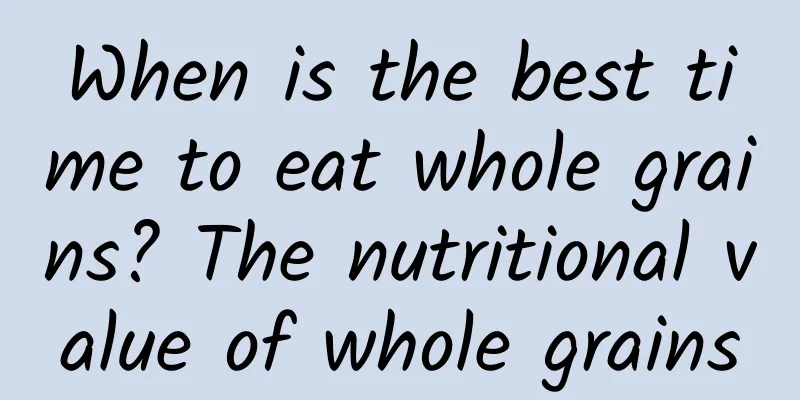When is the best time to eat whole grains? The nutritional value of whole grains

|
Different whole grains have different nutrients. Only by eating different types of whole grains in moderation can we achieve a balanced diet. Whole grains are rich in dietary fiber, which can replenish the energy needed by the human body in a day. So when is the best time to eat whole grains? Are whole grains carbohydrates? Let's learn more about whole grains and hope it will be useful to you. Contents of this article 1. When is the best time to eat coarse grains? 2. Nutritional value of whole grains 3. Are whole grains carbohydrates? 1When is the best time to eat whole grains?Coarse grains are rich in dietary fiber, which can promote gastrointestinal motility, but are not easy to digest. If you eat coarse grains alone, the best time to eat them is at noon, because 1 to 3 pm is the time when the small intestine meridian is active, the stomach digests well, the stomach and intestines absorb faster, and it can replenish the energy needed for the day, avoiding the intake of more food at night. If coarse grains are mixed with fine grains to make porridge and pancakes, they can be eaten for breakfast or dinner, which can effectively promote defecation and detoxification. Among them, coarse grains mixed with other fine grains are best eaten at dinner. Because the human body can better use the dietary fiber in coarse grains to eliminate waste in the body and lower blood lipids. 2Nutritional value of whole grainsCoarse grains mainly include cereals (corn, millet, red rice, black rice, purple rice, sorghum, barley, oats, rye, etc.), beans (soybeans, mung beans, red beans, black beans, broad beans, peas, etc.), and tubers (sweet potatoes, yams, potatoes, etc.). The nutrients contained in various coarse grains have their own strengths. Oats are rich in protein; millet is rich in tryptophan, carotene, iron and B vitamins; beans are rich in high-quality protein and fat; sorghum is rich in fatty acids and rich in iron. Compared with coarse grains, refined white rice and refined white flour lose some nutrients during grain processing, the most serious of which is the loss of vitamin B1 and inorganic salts. Coarse grains are simple to process and retain many nutrients that are not found in fine grains. From the perspective of nutrients, coarse grains have relatively low protein content and are rich in starch, cellulose, inorganic salts, and B vitamins. 3Are whole grains carbohydrates?Whole grains are carbohydrates. Coarse grains are relative to the refined grains such as refined rice and white flour that we usually eat. They mainly include corn, millet, black rice, sorghum, oats, buckwheat, wheat bran and various dry beans, such as soybeans, green beans, adzuki beans, mung beans, etc. |
<<: After thyroid surgery, I encountered persistent high blood pressure. This is what happened.
>>: Why do we need to boil dried apricots before sun drying (to remove excess water and bacteria)
Recommend
Bleeding at 40 days of pregnancy
Pregnancy is a process that most women will go th...
Excessive menstrual bleeding can be a health warning
Menstruation is a barometer of women's health...
Is private ultrasound knife true or false?
Everyone must have heard of the ultrasonic knife....
Why does my back hurt after I have a baby?
Many people will experience different symptoms af...
10 million Chinese are being used as experimental subjects for e-cigarettes!
A while ago, many netizens asked us to pick e-cig...
How to get rid of athlete's foot and treat foot odor, these foot baths can get rid of athlete's foot
Athlete's foot and foot odor are common foot ...
Is back pain at 13 weeks of pregnancy a sign of miscarriage?
The development of each fetus is different. If an...
Esophageal cancer caused by eating
The esophagus is a tubular organ that connects th...
What is the cause of leucorrhea with blood before menstruation?
It is normal to have leucorrhea before menstruati...
Can I get pregnant with an ovarian cyst?
In our lives, too many women have ovarian cysts. ...
How to treat cervical relaxation
During pregnancy, a woman's uterus will gradu...
What is breast hyperplasia?
Fibrocystic breast disease is a breast disease. I...
How to supplement estrogen after menopause?
Women generally lack estrogen after menopause. If...
Treatment for constipation and bad breath in women
Bad breath refers to a disease in which the insid...
Causes of vulvar itching after sex
Most people will do one thing after entering the ...









